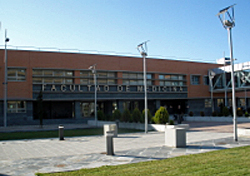|
 Abstract. Objective:
To estimate the prevalence of osteoporosis in
patients being treated with thyroid
hormone. Method: Cross-sectional
retrospective study of primary care
patients. Experimental Group: 112
patients diagnosed with subclinical
hypothyroidism receiving thyroid
hormone replacement therapy. Control
Group: 70 subclinical hypothyroid
patients not receiving thyroid
replacement therapy. Once the sample
was selected its members completed a
clinical questionnaire and underwent
a bone density scan with a validated
measuring device.
Results:
Among the 182 patients studied,
respectively, the experimental
groups’ mean age at diagnosis was
42.5 and the control patients’ was
41.2 years; 32.7% were smokers as
opposed to 33.2%; the coexistence of
two or more cardiovascular risk
factors were detected in 5.7% of
experimental patients as opposed to
?% of control patients; mean TSH was
6.67 mU/L and mean free T4 was 1.04
ng/dL, compared to 5.95 mU/L and
0.98 ng/dL. The experimental and
control groups significantly
differed in percentage of reduced
bone mineral density: respectively,
67% vs 35% lost bone mass, 86% vs
54% osteopenia, and 14% vas 5%
osteoporosis. Fifty-six percentage
of patients with bone loss were
women. Control patients use no
thyroid therapy for any time; in
contrast, 72% of experimental
patients used 100 or more mcg of T4
and 12% use 150 mcg/day or more.
Duration of T4 treatment was 1-to-10
years for 61.1% of the patients and
10 years or more for 19.5%.
Conclusions:
The data used in this study indicate
a high prevalence of bone loss in
patients with subclinical
hypothyroidism treated with
exogenous thyroxine. Abstract. Objective:
To estimate the prevalence of osteoporosis in
patients being treated with thyroid
hormone. Method: Cross-sectional
retrospective study of primary care
patients. Experimental Group: 112
patients diagnosed with subclinical
hypothyroidism receiving thyroid
hormone replacement therapy. Control
Group: 70 subclinical hypothyroid
patients not receiving thyroid
replacement therapy. Once the sample
was selected its members completed a
clinical questionnaire and underwent
a bone density scan with a validated
measuring device.
Results:
Among the 182 patients studied,
respectively, the experimental
groups’ mean age at diagnosis was
42.5 and the control patients’ was
41.2 years; 32.7% were smokers as
opposed to 33.2%; the coexistence of
two or more cardiovascular risk
factors were detected in 5.7% of
experimental patients as opposed to
?% of control patients; mean TSH was
6.67 mU/L and mean free T4 was 1.04
ng/dL, compared to 5.95 mU/L and
0.98 ng/dL. The experimental and
control groups significantly
differed in percentage of reduced
bone mineral density: respectively,
67% vs 35% lost bone mass, 86% vs
54% osteopenia, and 14% vas 5%
osteoporosis. Fifty-six percentage
of patients with bone loss were
women. Control patients use no
thyroid therapy for any time; in
contrast, 72% of experimental
patients used 100 or more mcg of T4
and 12% use 150 mcg/day or more.
Duration of T4 treatment was 1-to-10
years for 61.1% of the patients and
10 years or more for 19.5%.
Conclusions:
The data used in this study indicate
a high prevalence of bone loss in
patients with subclinical
hypothyroidism treated with
exogenous thyroxine.
Keywords • Bone
mass loss • Osteopenia •
Osteoporosis • Subclinical
hypothyroidism • Thyroxine
replacement
Citation:
Tárraga López,P.J., de Mora, F.N.,
Rodríguez Montes, J.A., Solera
Albero, J., Naharro Mañez, A., Frias
López, Mª C.:Osteoporosis in
patients with subclinical
hypothyroidism treated with thyroid
hormone replacement. Thyroid Science,
6(6):CLS1-9, 2011.
Full
Text Free
(pdf)

© 2011
Thyroid Science
|

